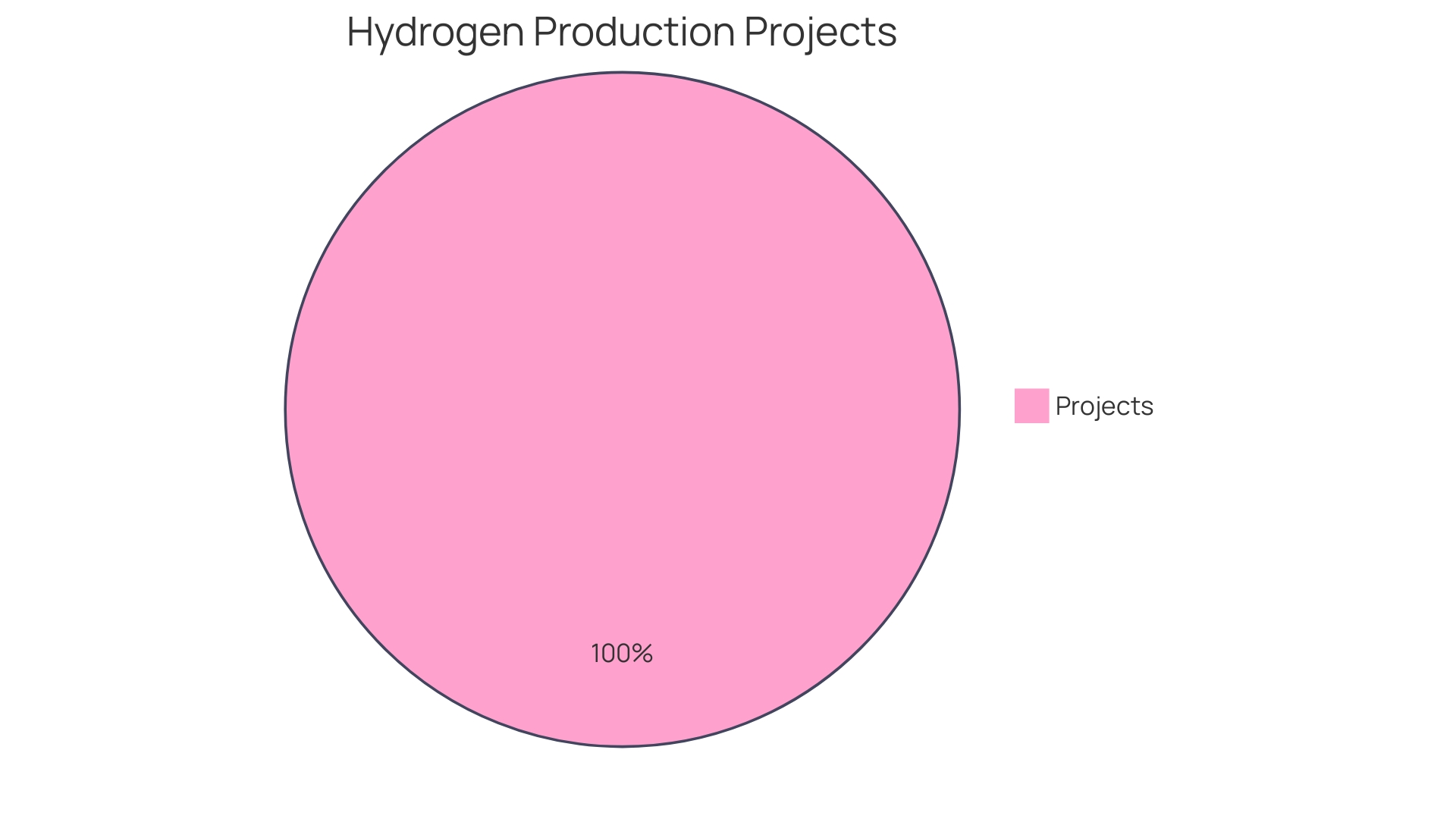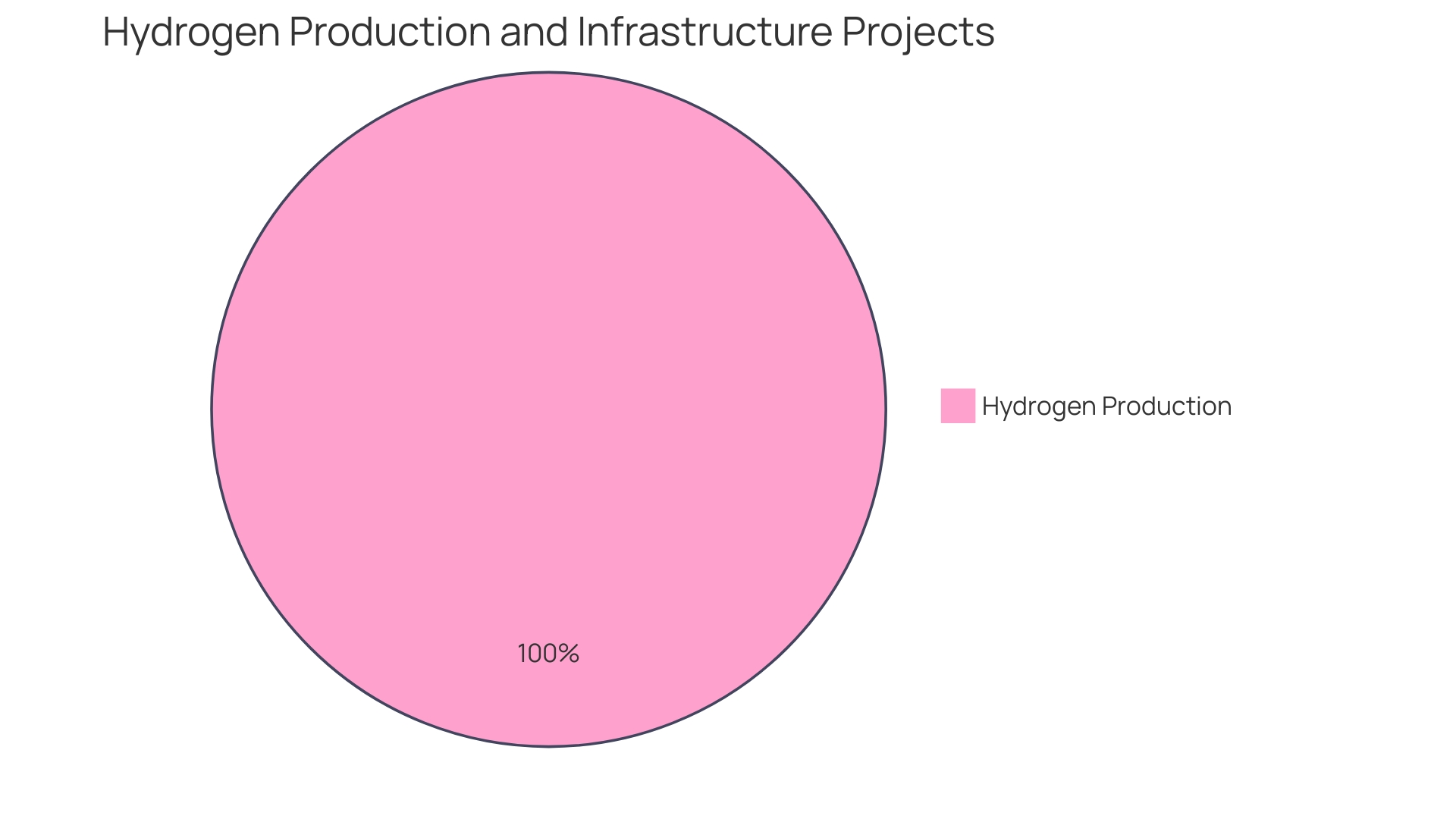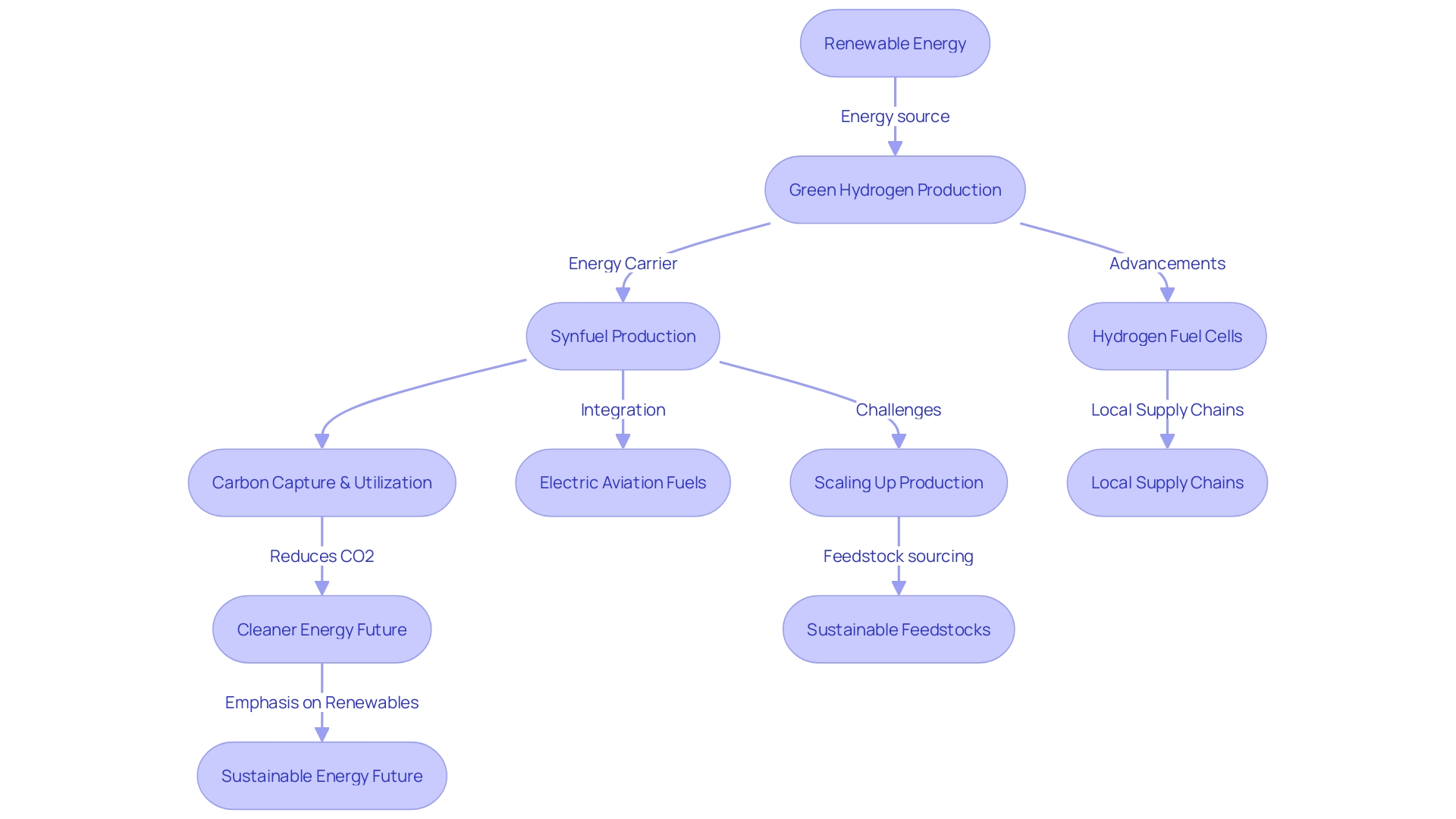Introduction
Synthetic fuels, also known as synfuels, have emerged as a crucial component in the renewable energy landscape. These fuels, manufactured from renewable resources, offer a sustainable alternative to traditional fossil fuels. With a focus on reducing carbon emissions, synfuels are gaining traction across various industries.
From transportation to aviation, synfuels provide adaptable solutions that can seamlessly integrate with existing infrastructure and internal combustion engines. Moreover, synfuels offer economic potential, fostering job creation and innovation in the renewable energy sector. Leading companies, such as ExxonMobil and Shell, are investing in research and development to enhance the efficiency and eco-friendliness of synfuel manufacturing.
The future prospects of synfuels are promising, with advancements in carbon capture and utilization and the integration of hydrogen fuel cells. However, challenges such as scaling up production and sourcing sustainable feedstocks remain. By prioritizing research, policy support, and collaborative efforts, the synfuel industry can continue to evolve and contribute to a cleaner and more sustainable energy future.
Definition and Types of Synfuels
Synthetic fuels, often abbreviated as synfuels, represent a class of fuels synthesized through various chemical processes from renewable or alternative sources, rather than direct extraction from natural deposits. These fuels are engineered to have similar properties to traditional fossil fuels, such as gasoline, diesel, and jet fuel, with the added benefit of more sustainable production pathways. Synfuels encompass a diverse range, from biofuels and hydrogen-based options to gas-to-liquids (GTL) technologies.
Biofuels, such as biodiesel and renewable diesel, primarily derive from vegetable oils—over 80% of their production, to be exact—with the remainder coming from animal fats. These bio-based diesels, which are commonly blended into traditional diesel fuel, are supported by similar regulations and utilize mature technologies for production. Interestingly, the majority of biodiesel is made from cooking oil equivalents like soybean and canola oil, while corn oil, often a byproduct of ethanol production, is typically reserved for animal feed.
The production of second-generation biofuels uses non-edible plant biomass, such as wood residues, sugarcane bagasse, or corn stover, which doesn't compete with food resources. This is a significant step forward from first-generation biofuels that relied on food crops like corn and sugarcane, leading to concerns about land and water resource allocation.
A key attribute of biofuels is their reduced net CO2 emissions across their lifecycle compared to fossil fuels, with some estimates suggesting up to 90% lower emissions. This characteristic makes them a strategic choice for sectors where electrification is challenging, such as heavy transport and industry.
In the aviation industry, sustainable aviation fuels (SAFs) are particularly promising, as they can be used with existing aircraft and infrastructure. For instance, the E-Fuel project by VTT and its industrial partners has demonstrated significant advancements in green hydrogen production, CO2 capture, and syntheses of e-fuels, showing the potential for high-quality, low-emission e-fuel production.
Educational initiatives, like the collaboration between Argonne National Laboratory and Waubonsee Community College, are also pivotal in understanding the impacts and applications of SAFs. Students are given the opportunity to analyze the lifecycle impacts of SAFs, fostering a multidisciplinary appreciation for this emergent energy sector.
The transition to synfuels is further supported by advancements in fuel cell technology, which, according to experts, could serve as standalone power plants, generating clean electricity from various natural fuels without the need for transmission lines.
As the demand for cleaner energy grows, synfuels stand out as a versatile and sustainable solution, with countries around the world steadily increasing their use. The rise in electric vehicle adoption—where approximately 1-in-5 new cars sold in 2023 is electric—highlights the global shift towards embracing renewable energy sources, including synthetic fuels.

Production Methods of Synfuels
Synthetic fuels, commonly known as synfuels, are crafted through sophisticated processes that reinvent raw materials into functional fuels. For instance, biomass, ranging from agricultural leftovers to specialized energy crops, can be converted into biofuels through fermentation or thermochemical pathways. A notable example of this is the utilization of corn stover—not the edible kernels, but the residual stalks, leaves, and husks. This agricultural byproduct exemplifies a sustainable approach to harnessing biomass.
In a groundbreaking demonstration of this concept, the E-Fuel project, led by VTT Research Professor Juha Lehtonen, showcased an integrated process of green hydrogen production, CO2 capture, and e-fuel synthesis. This venture culminated in the generation of high-quality paraffinic e-fuels, which, when field-tested, exhibited low emissions and provided insights into the economic viability and sustainability of e-fuel production.
Another vital technology in the synfuels domain is water electrolysis, which produces hydrogen—a potential fuel or precursor to synthetic hydrocarbons when combined with carbon dioxide. Hydrogen produced via electrolysis is deemed carbon-neutral when powered by renewable energy sources. According to the International Energy Agency (IEA), electrolyzers, specifically Proton Exchange Membrane (PEM) and Alkaline types, are commercially in use, albeit requiring enhancements to remain cost-effective.
Additionally, the Fischer-Tropsch process transforms natural gas or coal into liquid fuels. This traditional method is now being revisited to potentially incorporate renewable resources and reduce reliance on fossil fuels. A recent Journal of Catalysis study highlighted the laboratory use of CO2, when combined with hydrogen, to create valuable products such as lower olefins, alcohols, and fuels—a testament to the innovative strides being taken in the field of synfuels.
Educational efforts, such as the case study evaluated by Waubonsee Community College using the Greenhouse Gases, Regulated Emissions, and Energy Use in Technologies (GREET) model, demonstrate the industry's commitment to understanding the life-cycle impacts of sustainable aviation fuels (SAFs). These initiatives are crucial in shaping the future workforce that will navigate the complexities and opportunities of synfuels.
As the synfuels industry evolves, it holds the promise of decarbonizing sectors that are challenging to electrify, such as aviation and heavy-duty transport. The European Union, aiming for net-zero emissions by 2050, has set ambitious plans for renewable hydrogen production and importation to revolutionize energy consumption and reduce dependency on imported fossil fuels.

Raw Materials Used in Synfuel Production
Synthetic fuels, or synfuels, represent an innovative approach to renewable energy, leveraging diverse raw materials and advanced production techniques to create sustainable alternatives to traditional fossil fuels. For biofuels, the feedstocks have expanded beyond the conventional corn and sugarcane to include more sustainable and less ecologically impactful sources such as lignocellulosic biomass. This shift is significant, considering the textile and fashion industry's status as one of the world's largest polluters, second only to fossil fuels and agriculture. Innovations like CELF-based biorefineries have enabled the use of different biomass components, reducing reliance on food crops and mitigating associated greenhouse gas emissions and land use concerns.
Hydrogen-based synfuels, on the other hand, are garnering attention due to their potential for a continuous and sustainable energy supply, with hydrogen production via electrolysis using renewable electricity sources like wind and solar. This aligns with the growing need for processes that can run under fluctuating conditions, using sustainably obtained reactants.
Meanwhile, gas-to-liquids (GTL) technologies leverage carbon sources such as natural gas or even carbon dioxide, transforming them into hydrocarbons. The concept of 'defossilizing' the economy is gaining traction, moving away from burning ancient carbon sources and instead using CO2 - a byproduct of civilization - to produce valuable commodities like lower olefins, alcohols, and fuels. The innovative use of thin-film metal oxides and perovskites has led to the creation of effective devices that emulate photosynthesis, converting CO2 and water into syngas - a vital intermediate in the production of a variety of chemicals and fuels.
These advancements in the production of synfuels are not only a testament to the ingenuity of modern science but also a crucial step towards a more sustainable and autonomous operational future. They underline the importance of optimizing production and leveraging digital technologies to navigate the transition to a sustainable society, as envisioned by industry pioneers like Yokogawa.
Technological Processes Involved
Synthetic fuels, or synfuels, represent a frontier in energy production that harnesses a variety of technological processes to transform raw materials into viable fuel sources. These intricate processes include the critical stages of biomass pretreatment, gasification, fermentation, catalysis, and refining. Each step is meticulously designed to convert base materials into high-grade fuels that meet stringent quality standards.
Starting with biomass pretreatment, this stage is dedicated to preparing the biomass for conversion, stripping away impurities and simplifying complex structures to ensure a more efficient transformation process. This is followed by gasification, a high-temperature chemical reaction that turns solid biomass into a combustible gas, effectively liberating energy potential from the material.
Fermentation then takes center stage, as it leverages biological processes to convert sugars derived from biomass into biofuels, tapping into the natural efficiency of microbial systems. Catalysis plays a pivotal role throughout the synthesis, acting as a facilitator for the necessary chemical reactions to produce the desired fuel compounds.
Finally, the refining process ensures that the synthesized fuels are not only pure but also conform to the quality specifications required for their intended use. This meticulous refinement process echoes the insights of industry experts like Brian from Enviva and Alyssa, with their extensive experience in energy conservation and the forestry industry, emphasizing the importance of quality in fuel procurement and supply chain operations.
Moreover, the push for sustainable fuel alternatives is underscored by the recent advances in hydrogen fuel cells and the development of e-fuels, as highlighted by the successful outcomes of the E-Fuel project and the visionary work on artificial leaves for carbon capture. These innovations not only exemplify the progress in sustainable fuel technology but also represent the kind of advancements that industry veterans like Tom and Ric, with their deep expertise in energy and environmental sectors, are advocating for a 'defossilised' economy.
The evolution of synfuels production, and its increasing alignment with sustainable practices, is further exemplified by companies like Yokogawa, which are pioneering the integration of digital technologies into production optimization. Their approach to autonomous operations and sustainable society initiatives embodies the forward-thinking mindset required to meet the dynamic challenges and opportunities presented within the renewable energy landscape.
Overall, the roadmap for producing synthetic fuels is one of complexity and innovation, intertwining technological prowess with environmental stewardship to forge a path towards cleaner energy solutions that echo the ambitions and accomplishments of experts across the energy sector.

Benefits and Advantages of Synfuels
Synthetic fuels, commonly known as synfuels, are emerging as a pivotal component in the energy transition towards a more sustainable future. Unlike conventional fossil fuels, synfuels are not extracted but manufactured, primarily from renewable resources. This process provides a significant environmental advantage by harnessing energy sources such as solar and wind power, which are abundant and have a smaller carbon footprint.
One of the key attributes of synfuels is their compatibility with existing infrastructure and internal combustion engines, facilitating a seamless integration into the current energy system without necessitating extensive modifications. Synfuels can be utilized directly in vehicles or combined with traditional fuels to create blends that burn cleaner than pure fossil fuels, thereby contributing to a reduction in greenhouse gas emissions.
The production and use of synfuels also hold substantial economic potential. In the renewable energy sector, their development can lead to job creation and foster innovation. Companies such as Yokogawa are at the forefront of this transformation, providing cutting-edge technology for the measurement, control, and information processing necessary for the optimized production of synfuels. Their commitment to sustainable operations and the digitalization of the energy sector is instrumental in advancing the use of synfuels.
A real-world testament to the viability of synfuels is the HyFlexPower project in France, where green hydrogen—a synfuel—is produced from renewable energy and used to power industrial processes. This project demonstrates the practical application of synfuels in reducing the carbon footprint of energy-intensive industries.
Moreover, in the context of energy equity and affordability, synfuels contribute to a more equitable energy landscape. With the declining costs of renewable energy technologies, the production of synfuels is becoming increasingly cost-effective, offering a reliable energy source without the volatility of fossil fuel prices.
Experts in the field, such as Neil Chatterjee via RealClear Wire, have emphasized the crucial role of electricity as a necessity, not a luxury, in our modern society. Synfuels, including hydrogen fuel cells, offer a solution to the growing demand for electricity, providing decentralized, clean power generation. Furthermore, the integration of fuel cells into industrial and residential settings illustrates the potential of synfuels to enhance energy security and independence.
In the aviation sector, the development of synfuels is particularly promising. VTT Research Professor Juha Lehtonen highlights the successful development of e-fuels, which are compatible with current aircraft and can significantly reduce the aviation industry's reliance on conventional jet fuel.
As we look towards defossilizing the economy, synfuels stand out as a key technology. They represent a bridge between the carbon-based energy of the past and the clean, renewable-powered future, offering a sustainable path to meet climate goals and support a healthy, safe environment.
Environmental Impact and Sustainability
Synthetic fuels, or synfuels, represent a pivotal innovation in the quest for cleaner energy sources. These alternative fuels are garnering attention for their lower carbon footprint when derived from renewable resources, offering a promising substitute for conventional fossil fuels. As the demand for environmentally friendly alternatives rises, the focus has shifted towards harnessing green hydrogen, a variant of hydrogen that does not emit carbon during its production. Notably, hydrogen is the most abundant element in the universe and can be inexhaustibly sourced from seawater, presenting a virtually limitless supply.
When utilized correctly, synfuels have the power to substantially diminish air pollutants, such as sulfur oxides and particulate matter, thereby enhancing air quality. A noteworthy development in this arena is the Power-to-Hydrogen-to-Power technology, which converts electricity from renewable sources into green hydrogen, subsequently used to generate electricity even during periods without wind or sun. This innovative approach has been successfully demonstrated in real-world conditions at a Smurfit Kappa paper mill in France, marking a significant stride towards industrial decarbonization.
However, the production of synfuels is not without its challenges. It often requires considerable energy and water inputs, and the extraction of raw materials must be conducted sustainably to prevent adverse environmental impacts. The considerations extend to the entire supply chain, from sourcing to production, necessitating the adoption of sustainable practices to minimize the ecological footprint.
Encouragingly, companies like Yokogawa are leading the way in optimizing production and supply chain processes through digital technologies, paving the way for autonomous operations. Such advancements contribute to the efficient and responsible production of synfuels, ensuring that their environmental benefits are fully realized.
The synthesis of synfuels also benefits from the power-to-liquid pathway, which combines water and carbon dioxide to form liquid fuel. This innovative method, which is being explored by firms like Firefly, has the potential to generate a virtually endless supply of fuel, provided it is powered by renewable electricity and paired with effective carbon capture and storage.
In summary, synthetic fuels stand at the forefront of the energy transition, offering a cleaner, more sustainable alternative to fossil fuels. Their successful integration into the energy mix depends on the collective effort to implement sustainable practices throughout their production and use, thereby ensuring that their environmental advantages are maximized.
Applications and Uses of Synfuels
Synthetic fuels, commonly referred to as synfuels, are garnering attention for their versatility and potential in reducing carbon emissions across multiple sectors. In transportation, synfuels offer an adaptable solution; biofuels, for instance, can be seamlessly integrated with traditional fuels such as gasoline or diesel, enabling existing vehicles to operate more sustainably without the need for engine alterations. Hydrogen-based synfuels, on the other hand, are paving the way towards zero-emission transportation through their use in fuel cell vehicles, providing an environmentally friendly alternative to conventional internal combustion engines.
The aviation industry, with its high energy demands, stands to benefit significantly from gas-to-liquids synfuels, which can serve as a cleaner substitute for jet fuel. This innovation not only helps in reducing the carbon footprint of one of the world's most fuel-intensive modes of transport but also aligns with global decarbonization efforts.
Moreover, synfuels hold the promise of revolutionizing the chemical industry and industrial heating processes by serving as a cleaner feedstock. This transition is exemplified by projects like the HyFlexPower initiative at a Smurfit Kappa paper mill in France, where green hydrogen is used to fuel turbines, showcasing the feasibility of industrial decarbonization.
Recent developments in the production of synfuels, such as the inauguration of the DAWN solar fuel plant in Germany, highlight the growing commitment to sustainable fuel alternatives. The facility aims to produce around one million tons of solar fuel annually within a decade, marking a significant advancement towards meeting climate targets in the transport sector.
The momentum for synfuels is further evidenced by collaborative efforts in the energy and aviation sectors, with agreements in place to establish production capacities for sustainable aviation fuels derived from green hydrogen. Such initiatives not only reinforce Germany's leadership role in innovative technologies but also contribute substantially to the reduction of CO2 emissions in aviation, as emphasized by industry leaders.
With over thirty-three million vehicles in the US now utilizing alternative fuels, the diversification of the energy mix in transportation is evident. As the industry continues to evolve, the large-scale adoption of sustainable fuels becomes increasingly crucial in achieving the overarching goal of a carbon-neutral future.
Key Players and Innovations in Synfuel Technology
Synthetic fuels, also known as synfuels, embody a transformative approach to energy production, offering an alternative to traditional fossil fuels. Industry giants such as ExxonMobil, Shell, and Velocys are pioneering this field, leveraging cutting-edge technology to enhance the efficiency and eco-friendliness of synfuel manufacturing. These companies are channeling considerable resources into R&D to refine catalyst designs, streamline processes, and expand the array of feedstocks used in production, thereby advancing the capabilities of synfuel technologies.
A notable example of innovation within this sector is the aviation industry's exploration of sustainable synthetic aviation fuels. These fuels are essential for reducing reliance on fossil fuels, especially considering the limitations of battery-powered alternatives due to range and weight constraints. Projects like the E-Fuel initiative have shown promising advances, successfully integrating green hydrogen production, CO2 capture, and e-fuels synthesis. VTT Research Professor Juha Lehtonen highlighted the project's achievements, emphasizing the high-quality e-fuel produced and the valuable insights gained into the economic and environmental aspects of e-fuel production.
Similarly, ExxonMobil is actively pursuing carbon neutrality with its commitment to achieving net-zero Scope 1 and 2 greenhouse gas emissions from its operated assets by 2050. Its Rotterdam Manufacturing Complex, renowned for its energy efficiency, plays a pivotal role in this endeavor. The complex is also home to a state-of-the-art hydrogen plant that further signifies the company's investment in low-carbon energy solutions.
In the pursuit of reducing industrial CO2 emissions, ExxonMobil has partnered with FuelCell Energy to construct a pilot plant at the Rotterdam complex to evaluate a novel carbonate fuel cell technology. This collaboration aims to capture CO2 emissions efficiently, while also producing valuable byproducts. The EU's Emissions Trading System Innovation Fund and the Netherlands Enterprise Agency's DEI+ grant are co-funding this pilot project, underlining the significance of such innovations for a sustainable future.
The evolution of synfuel technology is also evident in the broader context of the hydrogen economy. Hydrogen fuel cells, which convert hydrogen and oxygen into electricity, have garnered attention as a sustainable energy source. The Hydrogen Economy's expansion, bolstered by government support, is crucial for achieving substantial emission reductions across various energy systems.
Collectively, these advancements and commitments from leading corporations, alongside supportive government policies, signal a robust future for synthetic fuels. They exemplify a concerted effort to address the pressing need for sustainable energy solutions across industries, particularly in sectors where decarbonization is challenging.
Future Prospects and Challenges
Synthetic fuels, or synfuels, are becoming increasingly vital in the global pursuit of a cleaner and more sustainable energy future. Their production leverages advancements in renewable energy technologies, promising a path towards greater efficiency and a reduced carbon footprint. Key to this evolution is the integration of carbon capture and utilization, which could significantly diminish CO2 emissions from synfuel production.
Industry pioneers like Yokogawa are driving this innovation by optimizing production and supply chain processes through digital technologies. Their efforts, alongside the successful HyFlexPower project at a Smurfit Kappa paper mill, have demonstrated the potential of using green hydrogen as a viable energy carrier. This approach showcases the feasibility of storing renewable electricity as hydrogen to later generate power, even when the sun doesn't shine or the wind doesn't blow.
Moreover, the aviation sector is exploring sustainable electric aviation fuels that fit within existing aircraft and infrastructure to mitigate reliance on fossil fuels. VTT's research in this field has yielded promising results, producing high-quality paraffinic e-fuels with low emissions. This progress is crucial as industries look to decarbonize and align with climate targets, with decarbonized hydrogen playing a pivotal role.
Despite these advances, scaling up production and sourcing sustainable feedstocks remain significant challenges. Ethylene production, for example, is a major industrial process releasing vast greenhouse gases, yet it's a key ingredient in countless products. Alternative methods like the artificial leaf, mimicking photosynthesis to convert CO2 and water into syngas, are groundbreaking steps toward cleaner production cycles.
In the energy sector, hydrogen fuel cells present an exciting prospect, with the potential to continuously generate electricity from the most abundant element in the universe. While most hydrogen is currently produced from natural gas, renewable-powered electrolyzers offer a sustainable alternative, endorsing hydrogen as a crucial energy storage medium.
The pathway to a synfuel-driven future is underscored by a growing emphasis on local supply chains, enabling even modest communities to produce and consume energy locally, fostering job growth in the green sector. Cost reductions in solar and battery technologies enhance this trend, with solar's learning rate at 44% and batteries at 23%, indicating impressive year-over-year improvements.
As Jules Verne once envisioned, hydrogen could indeed become an inexhaustible source of energy. Today's multi-billion-dollar hydrogen industry suggests we are closer to realizing this vision, with governments and companies alike racing to replace fossil fuels and combat climate change.
Collaborative efforts between industry, academia, and government bodies are essential to address these challenges. By continuing to invest in research and policy support, we can further the advancement of synfuels, aligning our energy practices with the urgent need for rapid decarbonization across all sectors.

Conclusion
In conclusion, synfuels are a crucial component in the renewable energy landscape, providing a sustainable alternative to traditional fossil fuels. With their adaptability and compatibility with existing infrastructure, synfuels offer a viable solution for reducing carbon emissions across various industries. Companies like ExxonMobil and Shell are investing in research and development to enhance the efficiency and eco-friendliness of synfuel manufacturing.
Advancements in carbon capture and utilization, along with the integration of hydrogen fuel cells, hold promise for the future of synfuels. However, challenges such as scaling up production and sourcing sustainable feedstocks remain. By prioritizing research, policy support, and collaborative efforts, the synfuel industry can continue to evolve and contribute to a cleaner and more sustainable energy future.
Synfuels offer significant environmental benefits, including lower carbon emissions and improved air quality. They also contribute to job creation, economic growth, and energy affordability. In sectors like aviation, synfuels show great potential for reducing carbon emissions and revolutionizing the industry.
Collaborative efforts between industry, academia, and government bodies are crucial in addressing the challenges of scaling up production and sourcing sustainable feedstocks. Continued investment in research and policy support will further advance synfuels, aligning our energy practices with the urgent need for rapid decarbonization.
In conclusion, synfuels represent an innovative and sustainable solution to meet our energy needs. They offer a cleaner and more sustainable alternative to traditional fossil fuels. With ongoing advancements and collaborative efforts, synfuels have the potential to revolutionize multiple sectors and contribute to a cleaner and more sustainable energy future.




